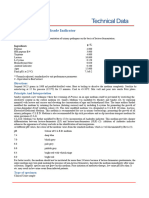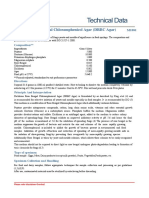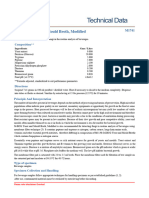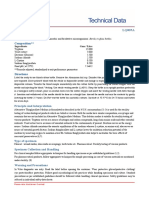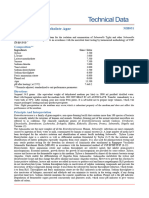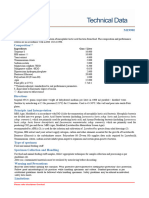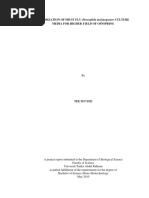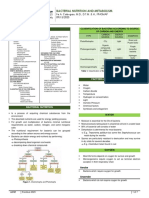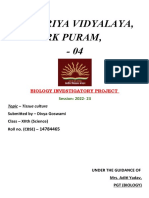M1255
M1255
Uploaded by
FERNANDA LEONHARDTCopyright:
Available Formats
M1255
M1255
Uploaded by
FERNANDA LEONHARDTCopyright
Available Formats
Share this document
Did you find this document useful?
Is this content inappropriate?
Copyright:
Available Formats
M1255
M1255
Uploaded by
FERNANDA LEONHARDTCopyright:
Available Formats
Tetrathionate Brilliant Green Bile Broth M1255
Intended Use:
Recommended for isolation and identification of Salmonellae.
Composition**
Ingredients Gms / Litre
Peptone 8.600
Bile 8.000
Sodium chloride 6.400
Calcium carbonate 20.000
Potassium tetrathionate 20.000
Brilliant green 0.070
Final pH ( at 25°C) 7.0±0.2
**Formula adjusted, standardized to suit performance parameters
Directions
Suspend 63.07 grams in 1000 ml purified / distilled water. Heat just to boiling. DO NOT AUTOCLAVE OR
REHEAT. Dispense into sterile tubes or flasks as desired.
Note: Due to the presence of calcium carbonate, the prepared medium forms opalescent solution with white precipitate.
Principle And Interpretation
Salmonella are gram-negative, facultatively anaerobic, non-sporulating, non-motile rods in the family Enterobacteriaceae.
They are widely distributed in animals affecting mainly the stomach and the intestines. These organisms are difficult to
differentiate biochemically from Escherichia coli. Tetrathionate Broth was originally described by Mueller (7) and later
modified by Kauffman (4,5). Tetrathionate Brilliant Green Bile Broth is used as an enrichment medium for Salmonella.
Enrichment broth is usually recommended to facilitate the recovery of small numbers of Salmonella species (4). Tetrathionate
Brilliant Green Bile Broth is also mentioned in I.P. (1) for isolation and identification of Salmonella species from foods,
water and other materials of sanitary importance.
Peptone in the medium provides nitrogenous and carbonaceous compounds, long chain amino acids, vitamins and
nutrients for growth of Salmonellae. Brilliant green and bile inhibit both gram-positive as well as some selected
gram-negative organisms. Potassium tetrathionate inhibits normal flora of faecal specimens. Sodium chloride helps in
maintaining osmotic equilibrium.
After incubation, streak the culture from Tetrathionate Brilliant Green Bile Broth (M1255) onto differential medium
for isolation and identification.
Tetrathionate Brilliant Green Bile Broth is not suitable for growth of Salmonella Typhi and Salmonella Paratyphi (6).
Type of specimen
Food samples
Specimen Collection and Handling
For food samples, follow appropriate techniques for sample collection and processing as per guidelines (9).
After use, contaminated materials must be sterilized by autoclaving before discarding.
Warning and Precautions
Read the label before opening the container. Wear protective gloves/protective clothing/eye protection/face protection. Follow
good microbiological lab practices while handling specimens and culture. Standard precautions as per established guidelines
should be followed while handling specimens. Safety guidelines may be referred in individual safety data sheets.
Please refer disclaimer Overleaf.
HiMedia Laboratories Technical Data
Limitations
1. For further confirmation, streak the enriched cultures after incubation, on plates of Brilliant Green Agar (M016),
MacConkey Agar (M081) and Bismuth Sulphite Agar (M027).
Performance and Evaluation
Performance of the medium is expected when used as per the direction on the label within the expiry period when stored
at recommended temperature.
Quality Control
Appearance
Light yellow to pale green homogeneous free flowing powder
Colour and Clarity of prepared medium
Bluish green coloured opalescent solution with white precipitate.
Reaction
Reaction of 6.3% w/v aqueous solution at 25°C. pH : 7.0±0.2
pH
6.80-7.20
Cultural Response
Cultural characteristics observed when subcultured on MacConkey Agar (M082) after an incubation at 35-37°C for 18-24
hours.
Organism Inoculum Growth Recovery Colour of
(CFU) colony
Escherichia coli ATCC 50-100 fair 20-30% pink to red with
25922 (00013*) bile precipitate
Salmonella Typhi ATCC 50-100 luxuriant >=50% colourless
6539
Salmonella Typhimurium 50-100 luxuriant >=50% colourless
ATCC 14028 (00031*)
Salmonella Enteritidis ATCC 50-100 luxuriant >=50% colourless
13076 (00030*)
Staphylococcus aureus >=104 inhibited 0%
subsp. aureus ATCC
25923 (00034*)
Staphylococcus aureus >=104 inhibited 0%
subsp. aureus ATCC
6538 (00032*)
Escherichia coli 50-100 fair 20-30% pink to red with
ATCC 8739 bile precipitate
Escherichia coli NCTC 9002 50-100 fair 20-30% Pink to red with
bile precipitate
Staphylococcus aureus >=104 inhibited 0%
NCIMB 9518
Key : *Corresponding WDCM numbers.
Storage and Shelf Life
Store between 10-30°C in a tightly closed container and the prepared medium at 15-25°C. Use before expiry date on the
label. On opening, product should be properly stored dry, after tightly capping the bottle in order to prevent lump formation
due to the hygroscopic nature of the product. Improper storage of the product may lead to lump formation. Store in dry
ventilated area protected from extremes of temperature and sources of ignition Seal the container tightly after use. Product
performance is best if used within stated expiry period.
Please refer disclaimer Overleaf.
HiMedia Laboratories Technical Data
Disposal
User must ensure safe disposal by autoclaving and/or incineration of used or unusable preparations of this product. Follow
established laboratory procedures in disposing of infectious materials and material that comes into contact with
sample must be decontaminated and disposed of in accordance with current laboratory techniques (2,3).
Reference
1. Indian Pharmacopoeia, 1996, Ministry of Health and Family Welfare, Govt. of India,
2. Isenberg, H.D. Clinical Microbiology Procedures Handbook 2nd Edition.
3. Jorgensen, J.H., Pfaller, M.A., Carroll, K.C., Funke, G., Landry, M.L., Richter, S.S and Warnock., D.W. (2015)
Manual of Clinical Microbiology, 11th Edition. Vol. 1.
4. Kauffman F., 1930, Hyg. Abt. I. Orig., 113, 148.
5. Kauffman F., 1935, Z. Hyg. Infektionskr., 117, 26.
6. MacFaddin J. F., 1985, Media for Isolation-Cultivation-Identification-Maintenance of Medical Bacteria, Vol. I, Williams
and Wilkins, Baltimore.
7. Mueller L., 1923, C. R. Soc. Biol., (Paris), 89, 434.
8. Murray P. R., Baron J. H., Pfaller M. A., Jorgensen J. H. and Yolken R. H., (Ed.). 2003, Manual of Clinical Microbiology,
8th Ed., American Society for Microbiology, Washington, D.C.
9. Salfinger Y., and Tortorello M.L., 2015, Compendium of Methods for the Microbiological Examination of Foods, 5th
Ed., American Public Health Association, Washington, D.C.
Revision : 03/ 2019
Disclaimer :
User must ensure suitability of the product(s) in their application prior to use. Products conform solely to the information contained in
this and other related HiMedia™ publications. The information contained in this publication is based on our research and development
work and is to the best of our knowledge true and accurate. HiMedia™ Laboratories Pvt Ltd reserves the right to make changes to
specifications and information related to the products at any time. Products are not intended for human or animal or therapeutic use but
for laboratory,diagnostic, research or further manufacturing use only, unless otherwise specified. Statements contained herein should not
be considered as a warranty of any kind, expressed or implied, and no liability is accepted for infringement of any patents.
HiMedia Laboratories Pvt. Ltd. Reg.office : 23, Vadhani Ind.Est., LBS Marg, Mumbai-400086, India. Customer care No.: 022-6116 9797 Corporate
office : A-516,Swastik Disha Business Park,Via Vadhani Ind. Est., LBS Marg, Mumbai-400086, India. Customer care No.: 022-6147 1919 Email:
techhelp@himedialabs.com Website: www.himedialabs.com
You might also like
- Micro Carrier Cell Culture Principles and MethodsDocument140 pagesMicro Carrier Cell Culture Principles and MethodssciencystuffNo ratings yet
- Pharmaceutical Microbiology: A Laboratory ManualFrom EverandPharmaceutical Microbiology: A Laboratory ManualRating: 3.5 out of 5 stars3.5/5 (3)
- Exercise 5Document31 pagesExercise 5triciallorin_19100% (1)
- M008SDocument3 pagesM008Sanulorance98No ratings yet
- Hicrome™ Ecc Selective Agar Base: Intended Use: CompositionDocument3 pagesHicrome™ Ecc Selective Agar Base: Intended Use: Compositionafiifa1015No ratings yet
- TDS GM108Document4 pagesTDS GM108florengrace.fg98No ratings yet
- M121IDocument2 pagesM121IventyfaniaNo ratings yet
- Urea Broth Base (Diagnostic Stuarts Urea Broth Base) : Intended UseDocument3 pagesUrea Broth Base (Diagnostic Stuarts Urea Broth Base) : Intended Use10605114No ratings yet
- MH581Document3 pagesMH581Abid Iqbal ARDNo ratings yet
- M121IDocument2 pagesM121INEHA VAGHELANo ratings yet
- M352Document3 pagesM352DBPNo ratings yet
- Technical Data: Hicrome™ Improved Salmonella AgarDocument3 pagesTechnical Data: Hicrome™ Improved Salmonella AgarAbhishek BanerjeeNo ratings yet
- M049 (1)Document3 pagesM049 (1)NEHA VAGHELANo ratings yet
- ™ Ec O157:H7 Agar, Modified: HicromeDocument3 pages™ Ec O157:H7 Agar, Modified: Hicromediana benites salcedoNo ratings yet
- Mannitol Salt Agar: Intended UseDocument4 pagesMannitol Salt Agar: Intended UseoktaNo ratings yet
- Pseudomonas Isolation HiCynth™ Agar BaseDocument2 pagesPseudomonas Isolation HiCynth™ Agar Baseuttam.micro404No ratings yet
- CLEDDocument3 pagesCLEDAnita HerreraNo ratings yet
- Sabouraud Dextrose Broth (Sabouraud Liquid Medium) : Intended UseDocument3 pagesSabouraud Dextrose Broth (Sabouraud Liquid Medium) : Intended UseCintya Arum SariNo ratings yet
- TDS M317Document3 pagesTDS M317darrendelfinoy9No ratings yet
- Msa PDFDocument4 pagesMsa PDFARATHY M NAIR 2147718No ratings yet
- Rappaport Vassiliadis Soya Broth (RVS Broth) : CompositionDocument2 pagesRappaport Vassiliadis Soya Broth (RVS Broth) : CompositionDuyên TrầnNo ratings yet
- Sabouraud Cycloheximide Chloramphenicol Agar: Intended UseDocument3 pagesSabouraud Cycloheximide Chloramphenicol Agar: Intended UsenadyasantikaNo ratings yet
- Chloran Rose Bengal Chloramphenicol Agar (DRBC Agar) : Intended UseDocument3 pagesChloran Rose Bengal Chloramphenicol Agar (DRBC Agar) : Intended Useபொ.தெய்வராஜன்No ratings yet
- Mitis Salivarius Agar Base: CompositionDocument2 pagesMitis Salivarius Agar Base: CompositionAbid SiddiquiNo ratings yet
- MH118Document4 pagesMH118Nanthicha KrajangpawNo ratings yet
- M108DDocument3 pagesM108Dadrijaamukherjee27No ratings yet
- EMB Agar: Composition Intended UseDocument3 pagesEMB Agar: Composition Intended UseAbdulrahmanNo ratings yet
- Luria Bertani Agar, Miller (Miller Luria Bertani Agar) : Intended UseDocument2 pagesLuria Bertani Agar, Miller (Miller Luria Bertani Agar) : Intended Usecrazyknowledge10No ratings yet
- Clostridial Agar: Intended UseDocument3 pagesClostridial Agar: Intended Usesg.comNo ratings yet
- Himedia M933Document3 pagesHimedia M933linaNo ratings yet
- BETA-SSA Agar (Group A Streptococci Selective Agar)Document3 pagesBETA-SSA Agar (Group A Streptococci Selective Agar)uttam.micro404No ratings yet
- Malonate Broth PDFDocument2 pagesMalonate Broth PDFSherly MardianaNo ratings yet
- PDA With ChlorampenicolDocument2 pagesPDA With ChlorampenicolIrene Ratri Andia SasmitaNo ratings yet
- M1297ADocument3 pagesM1297Ateena jacobNo ratings yet
- M031IDocument3 pagesM031Idarrendelfinoy9No ratings yet
- Lysine Decarboxylase PDFDocument3 pagesLysine Decarboxylase PDFSherly MardianaNo ratings yet
- M-BCG Yeast and Mould Broth, Modified: Intended UseDocument3 pagesM-BCG Yeast and Mould Broth, Modified: Intended UseWilliamNo ratings yet
- MM242Document3 pagesMM242Anand H SNo ratings yet
- Technical Data: Plate Count Agar (Standard Methods Agar)Document2 pagesTechnical Data: Plate Count Agar (Standard Methods Agar)பொ.தெய்வராஜன்No ratings yet
- Tryptic Soya Agar: Intended UseDocument2 pagesTryptic Soya Agar: Intended UseGopi NathNo ratings yet
- Agar EdwardsDocument2 pagesAgar EdwardsGeraldine CacaceNo ratings yet
- LQ007ADocument3 pagesLQ007Aபொ.தெய்வராஜன்No ratings yet
- M1643 LSTB MediumDocument2 pagesM1643 LSTB Mediumayuningtyas wahyuNo ratings yet
- Technical Data: Enriched Thioglycollate BrothDocument3 pagesTechnical Data: Enriched Thioglycollate Brothபொ.தெய்வராஜன்No ratings yet
- M1991IDocument3 pagesM1991IWindi LestariNo ratings yet
- SMH118CDocument4 pagesSMH118CNanthicha KrajangpawNo ratings yet
- Buffered Peptone Water: Intended UseDocument3 pagesBuffered Peptone Water: Intended UseUlliaNo ratings yet
- RM007Document3 pagesRM007Gopi NathNo ratings yet
- MH031 Xylose-Lysine-Deoxycholate Agar, HarmonizedDocument4 pagesMH031 Xylose-Lysine-Deoxycholate Agar, Harmonizedtogapn470No ratings yet
- M001 PDFDocument3 pagesM001 PDFkeresahanmuNo ratings yet
- TDS MH081Document4 pagesTDS MH081darrendelfinoy9No ratings yet
- Rose BengalDocument3 pagesRose BengalKhaza VinodNo ratings yet
- MH096Document3 pagesMH096Rocío CPérezNo ratings yet
- Buffered Peptone Water, GranulatedDocument3 pagesBuffered Peptone Water, GranulateduttamNo ratings yet
- Pseudomonas Agar (For Pyocyanin) (In A Accordance With IP 2007)Document2 pagesPseudomonas Agar (For Pyocyanin) (In A Accordance With IP 2007)sezinaltiokkNo ratings yet
- TechnicalDocument2 pagesTechnicalnafiw31466No ratings yet
- Malt Extract Agar: Intended UseDocument3 pagesMalt Extract Agar: Intended UseMimma MonicaNo ratings yet
- MH144 SJSMSNDocument3 pagesMH144 SJSMSNsulistyani sapardiNo ratings yet
- Plate Count Agar (Standard Methods Agar) : Intended UseDocument3 pagesPlate Count Agar (Standard Methods Agar) : Intended UsenuraenirianNo ratings yet
- M1990IDocument2 pagesM1990IDr. Shantanu KodapeNo ratings yet
- LQ181VDocument3 pagesLQ181Vsatyen.ghosh1111No ratings yet
- MP5332Document3 pagesMP5332satyen.ghosh1111No ratings yet
- Fermentasi Substrat PadatDocument23 pagesFermentasi Substrat PadatSulthon AminNo ratings yet
- XXXCCCDocument83 pagesXXXCCCDipayan Das0% (1)
- Orchid Seed & Tissue Culture Media Recommendation Guide: Phytotechnology Laboratories®Document10 pagesOrchid Seed & Tissue Culture Media Recommendation Guide: Phytotechnology Laboratories®wkm782No ratings yet
- Microbiological Procedures Nutritional and Dietary SupplementsDocument7 pagesMicrobiological Procedures Nutritional and Dietary Supplementsainun endarwatiNo ratings yet
- Abstract 1990Document23 pagesAbstract 1990kim_duenasNo ratings yet
- SOP For Procurement of CultureDocument5 pagesSOP For Procurement of Culturegreen solution100% (3)
- Micro - SupDocument9 pagesMicro - SupAbdoulhaleem MoNo ratings yet
- CAT Nº: 1099: Macconkey Agar With Sorbitol Iso 16654Document2 pagesCAT Nº: 1099: Macconkey Agar With Sorbitol Iso 16654Solesita AgredaNo ratings yet
- Biggy Agar (Bismuth Glucose Glycine Yeast Agar) : Instructions For Use - Ready-To-Use Plated MediaDocument3 pagesBiggy Agar (Bismuth Glucose Glycine Yeast Agar) : Instructions For Use - Ready-To-Use Plated MediaShoaib MughalNo ratings yet
- Name Different Types of Media and Give Examples. A. Basal MediaDocument2 pagesName Different Types of Media and Give Examples. A. Basal MediaScar ShadowNo ratings yet
- Principles of Animal Cell CultureDocument305 pagesPrinciples of Animal Cell CultureJa Cansino88% (8)
- Growth Promotion Test Guide For Media Used in Sterility TestsDocument5 pagesGrowth Promotion Test Guide For Media Used in Sterility Testshoria96No ratings yet
- Sensory Training Kits: Siebel Institute of TechnologyDocument16 pagesSensory Training Kits: Siebel Institute of Technologydiego jesus100% (1)
- Inoculum DevelopmentDocument1 pageInoculum Developmentrocky00023100% (5)
- MicrobiologyDocument40 pagesMicrobiologyS V S VardhanNo ratings yet
- NOTES - Bacterial NutritionDocument24 pagesNOTES - Bacterial NutritionDETECTIVE CONANNo ratings yet
- Antimicrobial Activities of Extracts and Flavonoid Glycosides of Corn Silk (Zea Mays L)Document7 pagesAntimicrobial Activities of Extracts and Flavonoid Glycosides of Corn Silk (Zea Mays L)ji jiNo ratings yet
- Impact of Bap and Iaa in Various Media Concentrations and Growth Analysis of Eucalyptus CamaldulensisDocument5 pagesImpact of Bap and Iaa in Various Media Concentrations and Growth Analysis of Eucalyptus CamaldulensisInternational Journal of Innovative Science and Research TechnologyNo ratings yet
- Food Microbiology and ParasitologyDocument23 pagesFood Microbiology and ParasitologyStephen Kariuki67% (3)
- NHS - Water Sources and Potential Pseudomonas Aeruginosa Contamination of Taps and Water SystemsDocument26 pagesNHS - Water Sources and Potential Pseudomonas Aeruginosa Contamination of Taps and Water SystemsSérgio GnipperNo ratings yet
- امتحان مايكرو 2Document14 pagesامتحان مايكرو 2Tariq Hasan AhmedNo ratings yet
- US20130344550A1Document18 pagesUS20130344550A1Lourence Albert Moreno MoleñoNo ratings yet
- Validation of Microbial Recovery From Pharmacopeial Articles EpaDocument10 pagesValidation of Microbial Recovery From Pharmacopeial Articles EpaMarco HernandezNo ratings yet
- Glycerol ProductionDocument22 pagesGlycerol ProductionAlejandra Adrian TejadaNo ratings yet
- Tissue CultureDocument32 pagesTissue CultureYash Wardhan100% (7)
- Ncm0105 Ts En-UsDocument2 pagesNcm0105 Ts En-UsJonathan GodoyNo ratings yet
- Chapter 4 Unit 1 Brock Biology of Microorganisms, Ebook, Global EditionDocument40 pagesChapter 4 Unit 1 Brock Biology of Microorganisms, Ebook, Global Edition22063 - Trần Chí HiệpNo ratings yet
- 2.6.13. Microbiological Examination of Non-Sterile Products: Test For Specified Micro-OrganismsDocument11 pages2.6.13. Microbiological Examination of Non-Sterile Products: Test For Specified Micro-OrganismsLeilNo ratings yet










